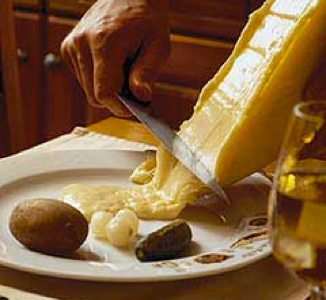Do Not Look Under the Cheese
During my life I have used many foods as a vehicle for peanut butter, but it turns out that cheese works just as well, though requires a bit more work. While some cheeses are good at room temperature, some of the really stinky ones like Raclette and Tomme can smell pretty unpalatable until you melt them under a hot lamp and make the top a little crunchy, at which point they are transformed into something with only a faint resemblance to their pre-heated state. This is something that Sean figured out years ago when he used to melt Velveeta on his veggies, a behavior that may have been a coping mechanism after he was attacked by a broccodile at a young age and developed an aversion to anything green. At any rate, while in Switzerland we began to appreciate what a great approach this is to eating. We ate prodigious amounts of cheese: it was eventually integrated into every meal of the day. We ate it for breakfast with Rosti, for lunch with bread and meat and for dinner with just about everything else. Starting with the premise that you are what you eat, then by extrapolation we can assume that Everett is what Melissa eats. Based on this we have calculated that his body composition is currently 8% Gruyere, 9% Raclette, 1% Tomme, 6% fondue, 2% each Appenzeller and Emmentaler, 3% Roquefort, 1.5% Pont l’Eveque and 1% Swiss air, keeping in mind that this might include some French air that blew across the border. And speaking of Everett, it is probably about time this blog returned to him to discuss some recently developed behaviors such as…
Anecdotal Evidence
Those of you watching the news for the last 24 hours have no doubt heard that CERN is firing up their Large Hadron Collider for the first time, and that there are numerous doomsday scenarios associated with these experiments, the purpose of which is to smash together subatomic particles at very high speeds to determine if Higgs bosons actually exist, or something like that. To be honest, we aren’t sure if “large†describes the hadrons or the collider. Anyway, scientists admit that these collisions might create some tiny black holes and that there is an infinitesimally small chance that the Canton of Geneva, along with portions of France, will be swallowed up in the process. Fortunately, CERN is just across the lake from us so we are able to observe firsthand any unusual events. For example, yesterday was a clear, sunny day except for a strange vapor cloud over the collider. Also, last night we heard a lot of low-frequency rumbling coming through the ground, and Everett seemed particularly fussy before bedtime. Aaron reported today that the entropy (or chaos, we’re not sure yet) in his office is increasing. Lastly, the turtle who lives at our house disappeared for several days and then suddenly reappeared when they started the collider. Certainly any one of these events in isolation could go unnoticed. But the low probability of all of them happening at once indicates that something big is likely to happen.
We were able to visit CERN a few days before this big event. And I have great news for those of you who study EEG source localization and have wondered for years what a dipole is: we found one (see picture above) and there are several more in this area.
Switzerland!
We are now at the Brocher Institute in Hermance, Switzerland. Let me first say that this institute is an extraordinary combination of natural resources and tireless, dedicated staff. I have no doubt that this place will soon earn the reputation that it deserves for supporting the science community.
If research is loosely defined as “what I am doing when I don’t know what I am doingâ€, then the purpose of this trip is to do research on a variety of subjects, and one of those subjects is cheese. I was familiar with two types of cheese when growing up: the kind that came in slices covered in cellophane and the kind that came in pressurized cans; moldy cheese was thrown out as soon as it was discovered. When you come from beginnings like this, the universe of cheese that the French and Swiss inhabit is just too much to take in at once, and one coping strategy is to prematurely conclude that you have your arms around the whole range of experiences. Soon after I got to know Melissa’s parents, Cress starting introducing me to some of his favorite cheeses, and what I once considered too pungent or weird I now crave but can rarely find at home (like Roquefort). So when we came to Switzerland (keeping in mind that we are in the French part of the country) I felt confident that I could handle just about anything. The Emmental and Gruyère we tried tasted like the champagne had already been added. During one Raclette lunch I consumed more cheese than I ever have before in a single sitting. The Appenzeller that the guide books described as “nauseating†was just as delicious, but even stronger. However, tonight I tried a local cheese that was almost overpowering. Rather than milk, this one smelled like the mud that the cow stands in. Melissa described it as “hay that has already gone through a digestive systemâ€. At this point we have only been here for a quarter of our stay and it remains to be seen if this is an acquired taste, so we will try it again right before we leave.
Part of the reason for the differences in cheeses between here and the U.S. may be the type of milk and how it is processed. One nearby grocer specifies for each cheese the animal the milk came from, whether it was raw or pasteurized and how long it was aged. Those of you in the U.S. who have sought out raw (unpasteurized) milk or cheeses made from it know how seriously this issue is taken. In an October 1, 2006 article in the Washington Post Magazine, Thomas Bartlett interviewed Ted Elkin, deputy director for the Office of Food Protection and Consumer Health at the Maryland Department of Health and Mental Hygiene (as an aside, I took a course in college called “Mental Hygiene†but I’ll save that for another entry). Mr. Elkin compared the sale of raw milk to marijuana and heroin (?!?). FDA employees consistently compare consuming raw milk to “playing Russian roulette with your health†(see FDA link on raw milk). In most states it is against the law to sell raw milk. It is also a federal crime to transport it across state lines with intent to sell it for human consumption. No doubt these officials are motivated by their desire to prevent an outbreak of listeria or some other bacteria that thrives on unprocessed milk. However, experiences in other countries suggest that raw milk is not as dangerous as it is made out to be by the FDA, and there are many people worldwide who argue strongly for the health benefits of milk straight from the farm. Pregnant French women eat unrefrigerated cheese made from raw milk, followed by a wine chaser, yet still have lower infant mortality rates than we do in the U.S. (I am generalizing and exaggerating about this behavior but not about infant mortality – the U.S. has the highest infant mortality rates of any industrialized nation). If I were to list the most important public health issues we face in the U.S., I doubt that raw milk would make it into the top 100. Tobacco, for example, which has no known health benefits and an adverse reaction rate of 100%, is legal and readily available in many different carcinogenic forms. If asked for another example I might mention how odd it is that you can legally ride a motorcycle in many states without a helmet, as long as you aren’t running an errand to buy unpasteurized milk. I think I’ll do some more research on this and return to it before the end of our trip.
Those of you who are still reading at this point might wonder if this blog is getting too far afield of its original purpose, and I am starting to wonder that myself. So I will close by saying that we are getting into a rhythm here at the Brocher Institute and Everett is a great traveler. He is usually only upset when he hasn’t been fed, and in that sense he is a lot like his parents.


